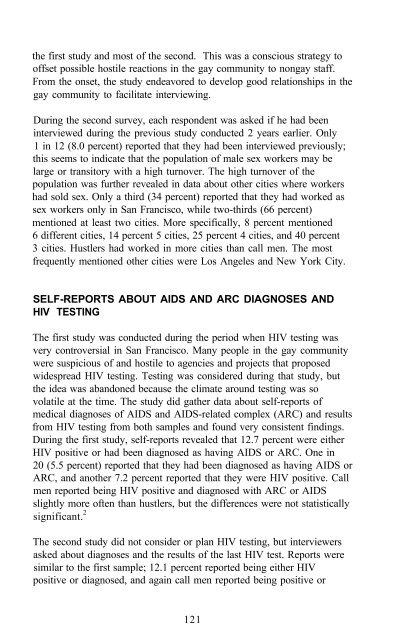The Context of HIV Risk Among Drug Users and Their Sexual Partners
The Context of HIV Risk Among Drug Users and Their Sexual Partners
The Context of HIV Risk Among Drug Users and Their Sexual Partners
You also want an ePaper? Increase the reach of your titles
YUMPU automatically turns print PDFs into web optimized ePapers that Google loves.
the first study <strong>and</strong> most <strong>of</strong> the second. This was a conscious strategy to<br />
<strong>of</strong>fset possible hostile reactions in the gay community to nongay staff.<br />
From the onset, the study endeavored to develop good relationships in the<br />
gay community to facilitate interviewing.<br />
During the second survey, each respondent was asked if he had been<br />
interviewed during the previous study conducted 2 years earlier. Only<br />
1 in 12 (8.0 percent) reported that they had been interviewed previously;<br />
this seems to indicate that the population <strong>of</strong> male sex workers may be<br />
large or transitory with a high turnover. <strong>The</strong> high turnover <strong>of</strong> the<br />
population was further revealed in data about other cities where workers<br />
had sold sex. Only a third (34 percent) reported that they had worked as<br />
sex workers only in San Francisco, while two-thirds (66 percent)<br />
mentioned at least two cities. More specifically, 8 percent mentioned<br />
6 different cities, 14 percent 5 cities, 25 percent 4 cities, <strong>and</strong> 40 percent<br />
3 cities. Hustlers had worked in more cities than call men. <strong>The</strong> most<br />
frequently mentioned other cities were Los Angeles <strong>and</strong> New York City.<br />
SELF-REPORTS ABOUT AIDS AND ARC DIAGNOSES AND<br />
<strong>HIV</strong> TESTING<br />
<strong>The</strong> first study was conducted during the period when <strong>HIV</strong> testing was<br />
very controversial in San Francisco. Many people in the gay community<br />
were suspicious <strong>of</strong> <strong>and</strong> hostile to agencies <strong>and</strong> projects that proposed<br />
widespread <strong>HIV</strong> testing. Testing was considered during that study, but<br />
the idea was ab<strong>and</strong>oned because the climate around testing was so<br />
volatile at the time. <strong>The</strong> study did gather data about self-reports <strong>of</strong><br />
medical diagnoses <strong>of</strong> AIDS <strong>and</strong> AIDS-related complex (ARC) <strong>and</strong> results<br />
from <strong>HIV</strong> testing from both samples <strong>and</strong> found very consistent findings.<br />
During the first study, self-reports revealed that 12.7 percent were either<br />
<strong>HIV</strong> positive or had been diagnosed as having AIDS or ARC. One in<br />
20 (5.5 percent) reported that they had been diagnosed as having AIDS or<br />
ARC, <strong>and</strong> another 7.2 percent reported that they were <strong>HIV</strong> positive. Call<br />
men reported being <strong>HIV</strong> positive <strong>and</strong> diagnosed with ARC or AIDS<br />
slightly more <strong>of</strong>ten than hustlers, but the differences were not statistically<br />
significant. 2<br />
<strong>The</strong> second study did not consider or plan <strong>HIV</strong> testing, but interviewers<br />
asked about diagnoses <strong>and</strong> the results <strong>of</strong> the last <strong>HIV</strong> test. Reports were<br />
similar to the first sample; 12.1 percent reported being either <strong>HIV</strong><br />
positive or diagnosed, <strong>and</strong> again call men reported being positive or<br />
121
















